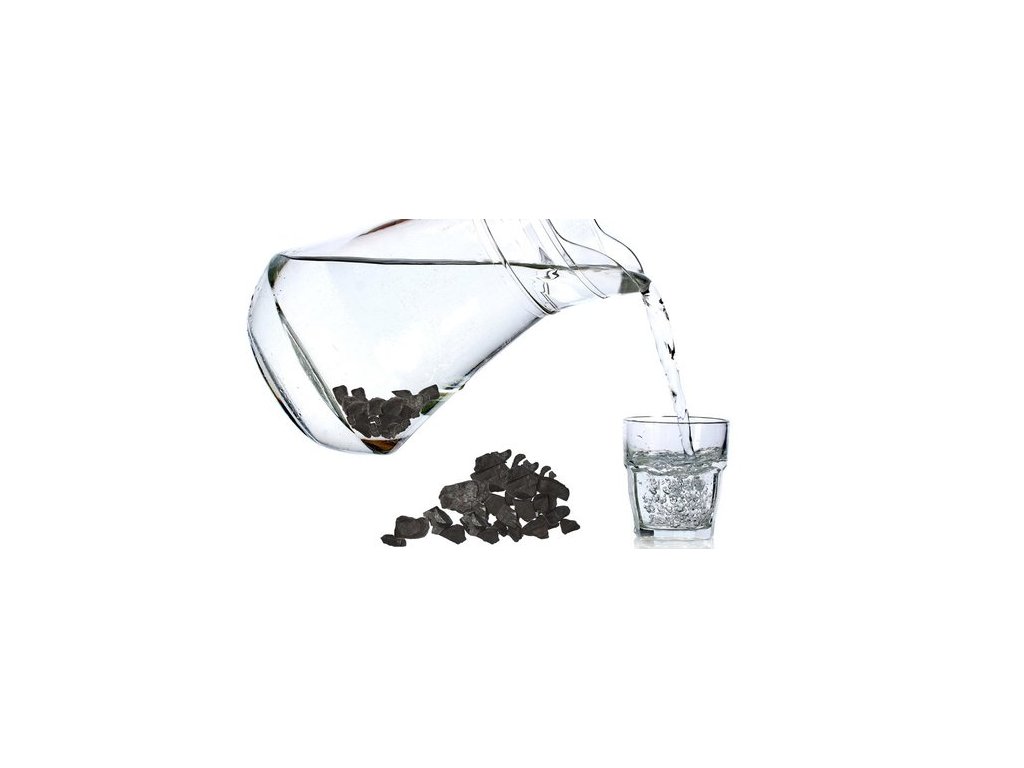 Shungite is a unique combination of carbon and silicate minerals found in an ancient deposit in Karelia Russia. Its uniqueness stems from the presence of hollow molecular carbon cages known as fullerenes embedded within the rock. Fullerenes (also called buckyballs) look like soccer balls—molecular hexagons and pentagons bound together in a hollow cage or tube. They were named after the noted architect, Buckminster Fuller because they follow the same architectural pattern as the geodesic domes he created.
Shungite is a unique combination of carbon and silicate minerals found in an ancient deposit in Karelia Russia. Its uniqueness stems from the presence of hollow molecular carbon cages known as fullerenes embedded within the rock. Fullerenes (also called buckyballs) look like soccer balls—molecular hexagons and pentagons bound together in a hollow cage or tube. They were named after the noted architect, Buckminster Fuller because they follow the same architectural pattern as the geodesic domes he created.
 About a billionth of a meter in diameter, fullerenes are incredibly stable. When propelled against a steel surface at 17,000 miles per hour, they literally bounce off. Clusters of fullerenes join diamonds and graphite as the third known form of crystalline carbon. Fullerenes were discovered in 1985 by Robert Curl and Richard Smalley. Together with Harold Kroto they synthesized these three-dimensional forms of carbon while trying to simulate the high-temperature, high-pressure conditions necessary for the formation of stars. Their discovery won them the Nobel Prize in chemistry in 1996. The natural existence of fullerenes remained unclear until they were verified in deposits of shungite . . .and since discovered in meteorites and in outer space. In 1991, Science magazine named fullerenes “molecule of the year,” calling them “the discovery most likely to shape the course of scientific research in the years ahead.” Scientists everywhere are researching fullerenes for their technological applications in material science, electronics, and nanotechnology. An entire “family” of buckyballs are known today—from 32-carbon atoms (C32) to giant fullerenes with 960 carbon atoms (C960). Fullerenes resonate in the far infrared spectrum with all forms of living matter. They are thought to be connected with the generation of life.
About a billionth of a meter in diameter, fullerenes are incredibly stable. When propelled against a steel surface at 17,000 miles per hour, they literally bounce off. Clusters of fullerenes join diamonds and graphite as the third known form of crystalline carbon. Fullerenes were discovered in 1985 by Robert Curl and Richard Smalley. Together with Harold Kroto they synthesized these three-dimensional forms of carbon while trying to simulate the high-temperature, high-pressure conditions necessary for the formation of stars. Their discovery won them the Nobel Prize in chemistry in 1996. The natural existence of fullerenes remained unclear until they were verified in deposits of shungite . . .and since discovered in meteorites and in outer space. In 1991, Science magazine named fullerenes “molecule of the year,” calling them “the discovery most likely to shape the course of scientific research in the years ahead.” Scientists everywhere are researching fullerenes for their technological applications in material science, electronics, and nanotechnology. An entire “family” of buckyballs are known today—from 32-carbon atoms (C32) to giant fullerenes with 960 carbon atoms (C960). Fullerenes resonate in the far infrared spectrum with all forms of living matter. They are thought to be connected with the generation of life.
Fullerenes in shungite
The rock deposit found in Russia (shungite) is the only known natural source of fullerenes on Earth (with the exception of a few meteorites). The rock has been studied extensively by Russian scientists, but only within the last few years has information regarding shungite reached the Western world. According to Russian and Ukrainian research, fullerene-rich shungite has the ability to neutralize numerous forms of negative energy. It attenuates electromagnetic emissions essentially providing protection from electromagnetic fields. Shungite has been successfully used for many years in Russia to assist patients with depression, trauma, and other emotional and psychological disturbances. Special shungite chambers have been constructed for this purpose.
Shungite for water
When placed in water, fullerenes in shungite attract and neutralize waterborne contaminants. Shungite has been used commercially in Russia as a water purification media since the 1990s. Among the list of contaminants it will remove are: bacteria (and other microbes), nitrates, heavy metals, pesticides, volatile organics, pharmaceuticals, chlorine, and fluoride (however, as with other forms of carbon filtration, it is not recommended for the removal of fluoride because it becomes burdened so rapidly). Its ability to enhance water goes far beyond filtration as demonstrated by the water from lake Onega near the shungite deposit in Russia. Water from the lake can be used today for drinking without any prior treatment—the result of thousands of years of interaction with shungite. One of the reasons shungite has the ability to neutralize contaminants is because the fullerenes within its composition can hold a tremendous amount of hydrogen. The stone has been documented to have a high oxidative/reductive capacity. Shungite water is known for its antioxidant effects.
Shungite is one of Mother Earth’s finest gifts for cleansing the environment. It works equally well for cleansing the human body. When water made with shungite is consumed, it balances and gently cleanses. Research indicates there is a decrease in the histamine in the bloodstream of those who drink shungite water—and a corresponding decrease in allergies. Shungite water also improves the elasticity of the skin and many skin problems. The water has been used externally for burns, rashes, insect bites, and small wounds. It has also been used internally for a long list of maladies.
How to Use Shungite to make fullerene-rich/hydrogen-rich water
1. Filter and structure your water according to any of the ways you prefer
2. Add shungite
a. Add 100 grams (about 1/2 cup of small stones) per liter (pint) of water. Allow the water to mature for 3 days or more before consuming.
3. It is best to leave shungite in the water until it is consumed. This helps to maintain the fullerene-like structure and the hydrogen in the water.
Cleansing Shungite
Nature continually cleanses shungite in the Earth’s energetic field and in the sunlight. It can be discharged, recharged and reused indefinitely by placing it on the Earth in direct sunlight. Every 3-6 weeks, depending on your water source and on the grade of shungite you are using, place shungite directly on the Earth in the full sun for several hours.
Russian scientist, Yuri Klavdievitch gives a 10 minute lecture on shungite – with English subtitles. Watch it on YouTube


